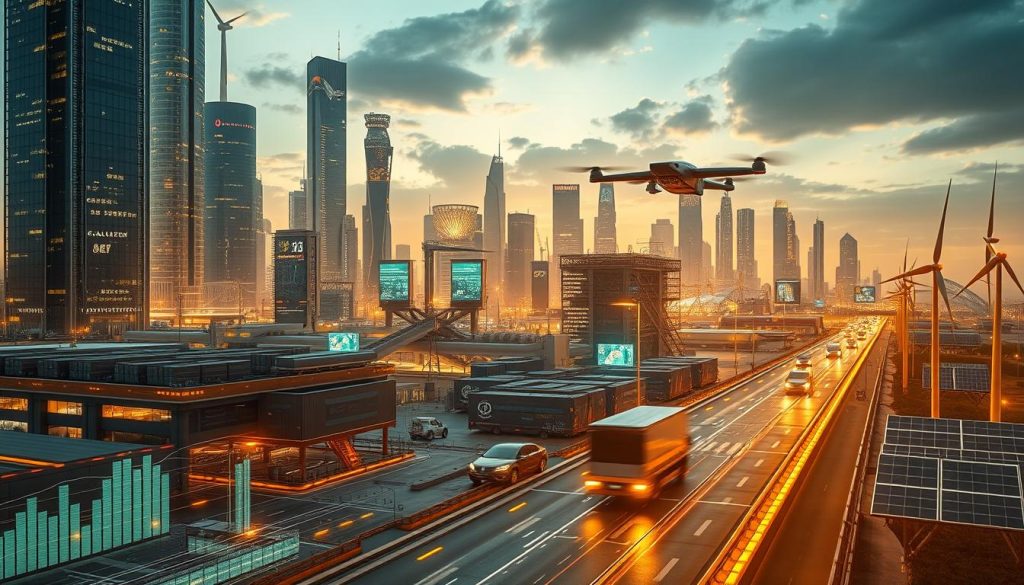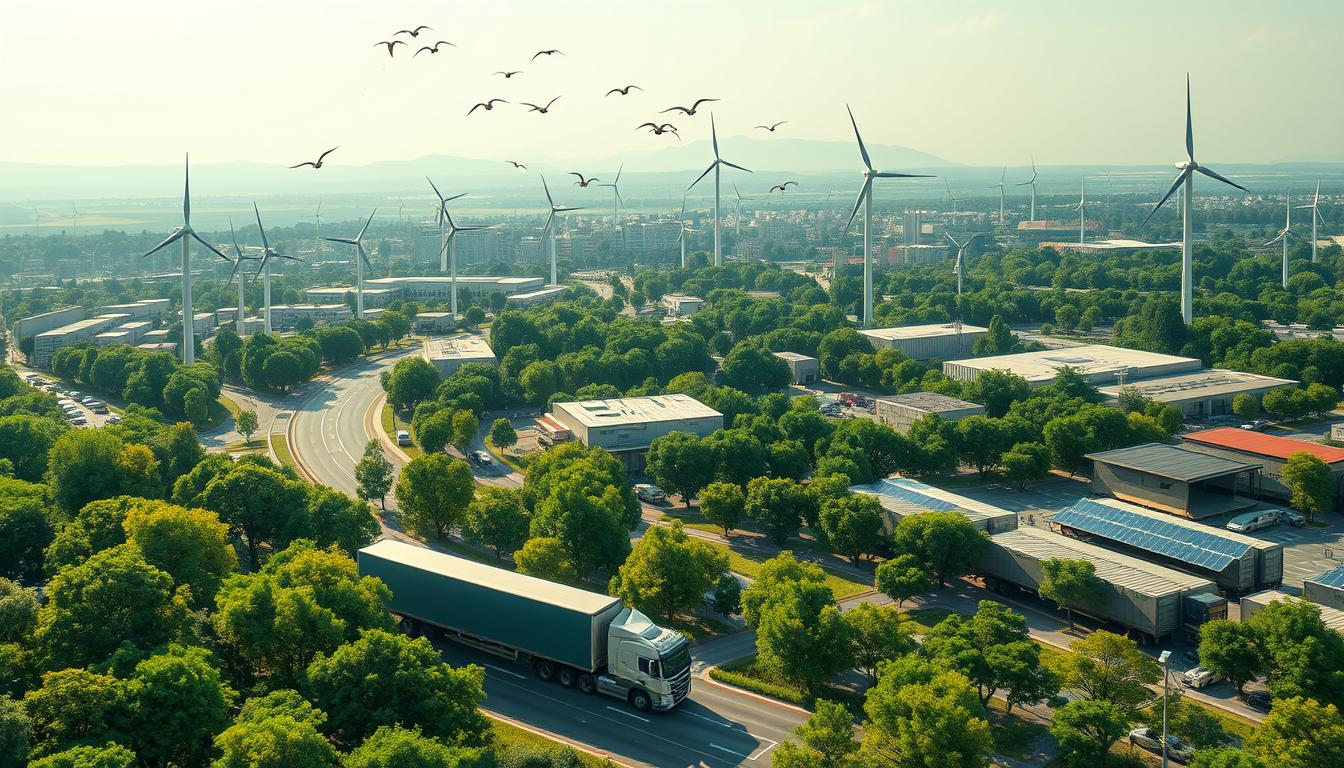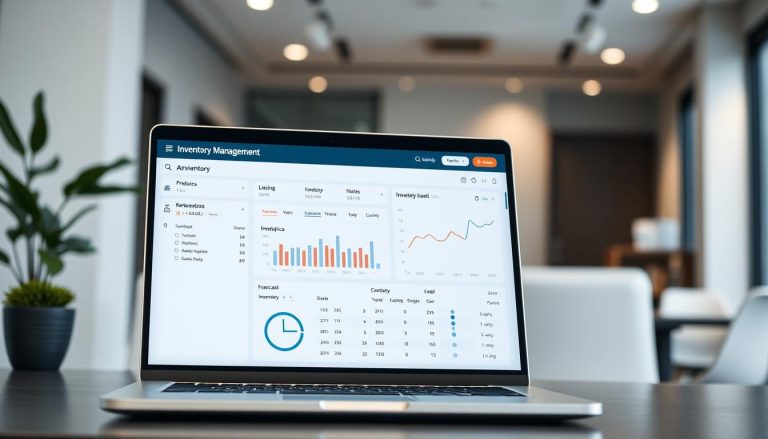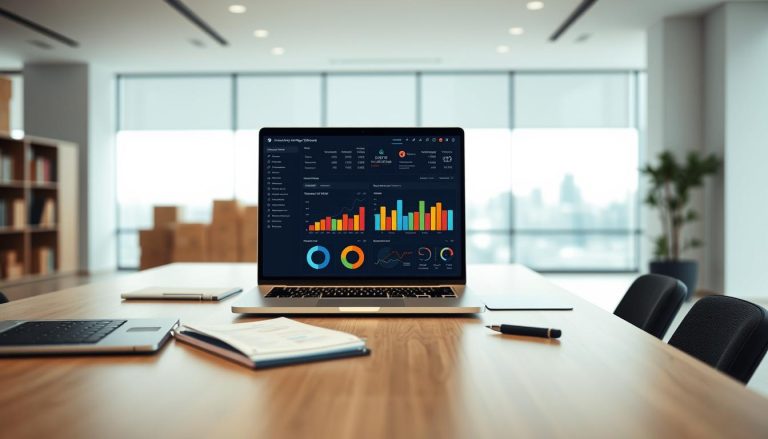Green Logistics: Discover the Sustainable Supply Chain Solution
Green logistics, also known as sustainable logistics or eco-logistics, aims to reduce environmental impact. It covers transport, warehousing, packaging, and distribution while maintaining service quality. It answers a common question in the U.S.: what is green logistics in simple terms?
The International Energy Agency states that transport is responsible for about 24% of global energy-related CO2 emissions. This makes environmental logistics critical for managing climate and risk. A sustainable supply chain uses eco-friendly transportation, energy-efficient sites, and waste prevention to mitigate these risks.
This article explores how green shipping practices, cleaner fuels, and route optimization reduce emissions and costs. It discusses energy-smart warehousing, right-sized packaging, and circular flows to keep materials in use. It also highlights solution providers like Detrack for routing and real-time tracking, SEKO for end-to-end services, and Shippingbo for WMS and green supplier integrations.
Readers will gain insights into building capabilities for a sustainable supply chain. This includes using IoT and AI for planning, control-tower visibility, and measurable reductions in fuel burn, energy use, and waste. The goal is to turn a sustainable supply chain into verifiable carbon reduction, compliance readiness, and a lasting competitive advantage for U.S. logistics networks.
Introduction to Green Logistics and the Sustainable Supply Chain
Green logistics focuses on moving goods with less environmental impact and more efficient use of assets. It connects sourcing, transport, warehousing, and returns to measurable carbon and cost outcomes. In the United States, companies are driven by consumer demand, new regulations, and incentives to adopt sustainable practices.
Transport and warehousing are major energy consumers, reliant on fossil fuels. The International Energy Agency reports that transport is responsible for about 24% of global CO2 emissions. This makes logistics a critical area for companies to reduce their environmental footprint and achieve operational and financial benefits.
Why logistics is central to environmental responsibility
Freight networks significantly influence fuel consumption, congestion, and air quality. The choice of transport mode, load factors, and warehouse energy use determine a significant portion of emissions. Companies are adopting eco-friendly transportation, energy management, and packaging standards to minimize risks and comply with evolving U.S. regulations.
Providers like SEKO incorporate emissions accounting into their operations. Technology partners, such as Detrack and Shippingbo, offer real-time data on routes and warehouses. This enables accurate tracking and continuous improvement in sustainable supply chains.
How sustainability and efficiency align in modern supply chains
Route optimization reduces miles, idle time, and fuel consumption, improving delivery times. Energy-efficient warehouses lower electricity use and maintenance costs without compromising service levels. Right-sized packaging reduces materials and shipment weight, maximizing the benefits of eco-friendly transportation.
These strategies enhance utilization, stabilize lead times, and reduce variability. Environmental logistics boosts resilience and margins by lowering energy intensity and waste streams.
Key terms: sustainable supply chain, environmental logistics, eco-friendly transportation
- Sustainable supply chain: An operating model that embeds carbon reduction, resource efficiency, and circularity across sourcing, production, logistics, and returns.
- Environmental logistics: A set of practices that reduce pollution and waste in freight, warehousing, packaging, and distribution while maintaining service quality.
- Eco-friendly transportation: Use of electric and hybrid vehicles, alternative fuels such as biofuels or CNG, multimodal choices, and optimized routing to cut emissions.
| Driver | Operational Lever | Business Effect | Example in Practice |
|---|---|---|---|
| Regulation and incentives | Fleet electrification and fuel switching | Lower emissions and fuel variance | EV pilots on urban routes using eco-friendly transportation |
| Cost stability | Network and route optimization | Reduced miles and labor hours | AI-assisted dispatch via Detrack for dense delivery zones |
| Customer expectations | Right-sized packaging and returns design | Less waste and higher satisfaction | Automated cartonization and trackable reverse flows |
| Energy exposure | Warehouse efficiency upgrades | Lower utility spend and peak demand | LED retrofits and smart HVAC with real-time monitoring |
| Transparency | Emissions reporting and control towers | Auditable data and faster decisions | Integrated dashboards through Shippingbo and WMS analytics |
What is Green Logistics
Green logistics integrates responsible methods across the supply chain to cut emissions and waste. It maintains service levels and cost control. It links operational planning with measurable outcomes such as carbon footprint reduction and energy savings. It supports environmentally friendly distribution without sacrificing reliability.
Definition and scope across transportation, warehousing, packaging, and distribution
Green logistics applies clean technologies and efficient processes in transport, warehousing, packaging, and distribution. It uses electric and hybrid fleets, biofuels, and route optimization for fewer miles and less fuel. Facilities adopt LED lighting, smart HVAC, motion sensors, and on-site solar for lower energy demand.
Packaging shifts to recyclable, compostable, and reusable materials with right-sizing to reduce void fill and damage. Distribution focuses on efficient load planning, multimodal moves, last-mile optimization, and reverse logistics. This enables environmentally friendly distribution.
Balancing economic efficiency with ecological and social responsibility
Programs align operating efficiency with community and environmental goals. Fuel savings, consolidation, and optimized inventory lower costs while curbing noise, greenhouse gases, and hazardous risks. Firms like UPS, DHL, and Maersk use data-driven routing and modal shifts to pair service quality with carbon footprint reduction.
This balance relies on clear targets, verified data, and worker training. It also requires supplier standards and safe handling protocols that protect people and assets.
Core goals: carbon footprint reduction, energy efficiency, waste minimization, pollution prevention
- Carbon footprint reduction through cleaner vehicles, multimodal strategies, and advanced route planning.
- Energy efficiency in warehouses and fleets via LEDs, smart HVAC, telemetry, and regenerative braking.
- Waste minimization with lean inventory, packaging reduction, reuse programs, and returns refurbishment.
- Pollution prevention by mitigating air, water, and noise impacts and improving hazardous material controls.
| Domain | Primary Action | Operational Benefit | Environmental Outcome | Example Practice |
|---|---|---|---|---|
| Transportation | Route optimization and consolidation | Lower fuel spend and fewer miles | Meaningful carbon footprint reduction | Dynamic routing with AI for dense urban stops |
| Warehousing | LED lighting and smart HVAC | Reduced kWh per order | Energy efficiency and lower peak demand | Motion sensors in low-traffic zones |
| Packaging | Right-sizing and reusable materials | Less damage and freight class savings | Waste minimization and fewer materials | Corrugated redesign to cut void by 30% |
| Distribution | Multimodal and last-mile optimization | Improved on-time delivery | Environmentally friendly distribution | Rail for linehaul, e-vans for final mile |
Environmental Challenges in Traditional Logistics
Legacy freight models rely heavily on diesel trucks, bunker-fuel ships, and kerosene-powered jets. This setup puts a strain on urban air quality and increases energy demand in warehouses. The transition to more environmentally friendly logistics is hindered by fragmented fleets and aging assets. This slows down efforts to reduce the carbon footprint.
Transport-driven CO2 emissions and the IEA’s ~24% statistic
The International Energy Agency states that transport is responsible for about 24% of global energy-related CO2 emissions. Long-haul trucking, container shipping, and aviation are the main contributors due to their high fuel consumption. Inefficient routes, congestion, and empty backhauls exacerbate fuel burn and hinder efforts to reduce carbon footprint in cross-border networks.
Air, noise, and water pollution tied to fossil fuels and hazardous handling
Combustion engines emit particulates and nitrogen oxides, harming urban air quality. Continuous truck traffic, loading docks, and yard equipment contribute to noise pollution near residential areas. Mishandling hazardous materials risks spills that contaminate waterways, necessitating stricter environmental logistics controls and training.
Deforestation and waste from conventional packaging practices
The extensive use of virgin paper and corrugated cardboard puts pressure on forests, leading to habitat loss in sensitive areas. Excessive packaging, void fill, and poor handling contribute to waste in landfills. Energy-intensive refrigeration and HVAC in storage facilities also increase emissions, slowing carbon footprint reduction efforts in the packaging-to-warehouse sector.
Benefits of Adopting Green Logistics Practices
Embracing green logistics brings significant benefits to operations and finances. By integrating sustainability into transport, warehousing, and planning, companies can reduce their carbon footprint. This also enhances cost control and service quality.
Reduced environmental impact and lower operating costs
Optimizing routes and consolidating shipments reduces miles, idle time, and fuel consumption. Energy-saving technologies like LED lighting, smart HVAC, and motion sensors lower electricity use in warehouses. These efforts not only cut carbon emissions but also reduce fuel and utility expenses.
Modern WMS and telematics help minimize mispicks and empty runs. This leads to fewer returns, less waste, and better asset use in a sustainable supply chain.
Stronger brand reputation and stakeholder trust
Public commitments to cleaner transport and efficient facilities demonstrate responsible stewardship to stakeholders. Brands that show progress in reducing carbon emissions are preferred by customers who value responsible delivery and packaging.
Transparent reporting and third-party verification enhance accountability. This fosters stable partnerships and higher retention in a sustainable supply chain.
Regulatory compliance, incentives, and competitive advantage
Proactive adoption ensures compliance with tightening air and climate rules in the United States. Early adopters can access grants, tax credits, and utility rebates for clean vehicles, charging, and on-site renewables.
Logistics providers like SEKO benefit from resource efficiency and collaborative planning. Companies like Shippingbo focus on WMS-driven accuracy, while Detrack showcases analytics for better on-time performance. These capabilities reduce risk, unlock margin, and differentiate a sustainable supply chain through verifiable carbon footprint reduction.
- Cost levers: route optimization, consolidation, LED retrofits, smart HVAC, sensors
- Reputation levers: transparent metrics, supplier engagement, employee programs
- Compliance levers: grants, tax incentives, renewable adoption, fleet upgrades
Eco-Friendly Transportation and Green Shipping Practices
In the United States, shippers are moving towards eco-friendly transportation to meet corporate emissions targets and stabilize fuel costs. They use data-led planning, consolidated loads, and mode shifts to cut carbon emissions while maintaining service levels. This approach is key to green shipping practices.
Electric and hybrid vehicles, alternative fuels, and multimodal options
Fleet transitions now focus on battery-electric vans for dense urban routes and hybrid tractors for regional hauls. Compressed natural gas and advanced biofuels are used where charging is limited. Rail and ocean legs replace long road stretches to reduce cost per ton-mile and strengthen eco-friendly transportation outcomes.
Multimodal design aligns schedules across road, rail, and sea to maximize load factors. Partnerships with UPS, FedEx, and Maersk show how LNG vessels, shore power, and regenerative braking extend green shipping practices across corridors.
Route optimization to cut idle time, miles, and emissions
Advanced routing engines combine telematics, traffic, and weather to trim empty miles and idling. Detrack provides real-time visibility and dynamic sequencing, which lowers fuel consumption and improves on-time performance. Dynamic re-routing and time-window alignment support eco-friendly transportation while protecting delivery promises.
Shipment consolidation and stop-density gains reduce driver hours and maintenance cycles. The result is fewer trips, lower particulate exposure, and measurable progress under green shipping practices KPIs.
Last-mile strategies for urban deliveries and noise reduction
Micro-fulfillment hubs place stock near demand to shorten routes and curb congestion. Cargo bikes and e-cargo vans operate in downtown zones with zero tailpipe emissions and lower noise. These tactics fit municipal quiet-hours rules and advance eco-friendly transportation in crowded districts.
Off-peak deliveries, curbside bays, and quieter electric trucks limit dwell time and sound levels. When paired with data-led slotting and dynamic dispatch, green shipping practices scale across cities without sacrificing speed or reliability.
Green Warehousing Solutions and Energy Efficiency
Warehouses lead the way in sustainable supply chains by reducing energy use per order. Green warehousing focuses on efficient equipment, smart controls, and data-driven operations. These methods cut kilowatt-hours without slowing down operations.
LED lights with motion sensors lower energy use in less busy areas. Smart HVAC systems use variable-speed drives and demand-controlled ventilation. This keeps temperatures stable without wasting energy.
Adding skylights and clerestory windows boosts natural light. Passive shading and insulation reduce cooling needs during peak hours.
On-site renewables like solar or wind power replace grid electricity. Rooftop photovoltaics can power forklifts and support EV charging for yard tractors and vans. Battery storage helps even out energy use, reducing costs during high-tariff times.
Operational design plays a key role. Slot fast-moving items near docks to reduce truck travel. Use narrow-aisle racking where possible to increase storage space. Standardize pick paths and batch orders to lower equipment use.
Systems integration ensures everything works together. A WMS from SAP, Manhattan Associates, or Shippingbo manages inventory and tasks. This reduces travel, energy use, and boosts productivity in green warehousing.
These efforts bring clear benefits to sustainable supply chains. They lower utility costs, maintain stable conditions for safety and quality, and simplify audits. The outcome is a facility that meets corporate emissions goals and controls costs effectively.
Sustainable Packaging and Environmentally Friendly Distribution
Procurement and logistics teams now see packaging as a strategic tool for environmentally friendly distribution. They combine material science, cartonization logic, and returns design to reduce emissions and costs. This approach also clarifies what green logistics entails, linking packaging to transport efficiency and inventory protection.
Recyclable, biodegradable, compostable, and reusable materials
Companies are moving away from single-use plastics to more sustainable options. Brands like Amazon and Walmart are using curbside-recyclable mailers and returnable transit packaging. This reduces waste and damage rates.
Bio-based and mushroom-derived cushions are also being used. They protect fragile goods without using petroleum. These choices help reduce the pressure on forests by lowering virgin paper demand over time. Standardized specs with suppliers ensure verified material content and reduce contamination in downstream recovery streams.
Right-sizing packages to reduce material and transport emissions
Right-sizing reduces fiber, void fill, and dimensional weight. Carriers price based on size, lowering freight spend and CO2 emissions per order. AI-enabled cartonization in leading WMS suites, such as Manhattan and Blue Yonder, selects the smallest viable container and reduces over-boxing.
Shippers report fewer trucks on the road when load factors rise. Less air in parcels also cuts damage, preventing reshipments and additional handling emissions.
Customer take-back, recycling, and circular economy loops
Take-back programs collect used mailers, pallets, and containers for reuse or verified recycling. Retail and parcel networks, including UPS Access Point and FedEx OnSite, provide convenient drop-offs. These integrate with environmentally friendly distribution plans and clarify what is green logistics in practice.
Contracts can formalize deposit systems, refill models, and reverse freight calendars. Barcode-based tracking assigns custody, while WMS controls verify return condition. This enables multiple reuse cycles before end-of-life processing.
- Policy alignment: Supplier scorecards reference ISO 14001 and material certifications to ensure consistent inputs.
- Operational accuracy: Pack stations with dimensioners and weight checks improve pack fit and lower claim rates.
- Data control: Emissions factors tied to package size and material inform quarterly sustainability reporting.
Coordinated packaging policies, verified materials, and optimized cartons transform packaging into a driver of performance in environmentally friendly distribution.
Waste Reduction, Reverse Logistics, and Circular Economy
Enterprises view waste as a cost and a source of data. By aligning planning, returns, and recovery, they enable environmentally friendly distribution. This also leads to measurable carbon footprint reduction across the network.
Lean inventory and just-in-time to curb overstock and spoilage
Lean replenishment and just-in-time purchasing reduce excess stock. This cuts down on obsolescence and lowers storage energy. The result is fewer write-offs and less energy used for cooling and lighting in warehouses.
Retailers using demand sensing and safety-stock analytics achieve shorter cycles and fewer markdowns. This approach supports environmentally friendly distribution. It also contributes to carbon footprint reduction through optimized transport frequency and fuller loads.
Refurbish, repair, and recycle pathways for returns
Structured return pathways preserve value. Refurbish high-demand items, repair units with minor faults, and recycle the rest. This prevents landfill waste.
SEKO Logistics notes that reverse flows extend product life and sustain circular revenue. Clear work instructions and part harvesting recover components. Verified recyclers process residuals, aiding environmentally friendly distribution and consistent carbon footprint reduction.
Designing reverse logistics for value recovery and landfill avoidance
Dedicated return centers with standardized triage and disposition rules reduce dwell time and waste. Integration with WMS and OMS improves visibility. Carrier pick-ups and customer portals accelerate throughput.
Codified waste policies drive packaging minimization and material repurposing. Track diversion rates, recovery value, and avoided emissions. This validates environmentally friendly distribution and documents carbon footprint reduction at the enterprise and lane level.
- Operational levers: triage within 24 hours, serialized tracking, and parts harvesting SOPs.
- Network levers: zone-skipping for returns, consolidated line-hauls, and localized repair hubs.
- Policy levers: standardized packaging reuse, recyclable dunnage, and vendor scorecards.
| Metric | Definition | Business Impact | Sustainability Impact |
|---|---|---|---|
| Diversion Rate | Share of returns not sent to landfill | Lower disposal fees; higher resale | More material recirculation |
| Recovery Value | Revenue from refurbished or harvested parts | Improved margin on returns | Fewer new materials required |
| Avoided Emissions | CO2e prevented via reuse and optimized transport | Supports ESG targets and audits | Direct carbon footprint reduction |
| Cycle Time | Return receipt to disposition decision | Faster cash conversion | Less handling and energy use |
Technology, Data, and Real-Time Visibility for Sustainable Supply Chains
Real-time data now drives measurable gains in cost and carbon. Companies use connected assets and analytics to align green shipping practices with financial targets inside a sustainable supply chain.

IoT sensors and AI route planning cut fuel burn by monitoring engine load, tire pressure, temperature, and driver behavior. SEKO reports that sensor-driven maintenance and AI dispatch reduce empty miles and spoilage, supporting green shipping practices at scale. Data-driven emissions tracking consolidates telematics, fuel receipts, and utility data to produce auditable carbon calculations.
Control-tower visibility provides a single view of orders, inventory, and transportation. With alerting and exception workflows, teams prevent failed deliveries and reduce waste. A sustainable supply chain benefits when planners rebalance stock, shift modes, and avoid expedited moves triggered by blind spots.
WMS optimization improves slotting, reduces picks per order, and supports right-sized packaging. Shippingbo highlights that accurate slotting and cartonization lower material use and return rates, reinforcing green shipping practices while improving service levels.
Collaborative platforms and blockchain standardize supplier data and traceability. Shared ledgers record batch IDs, chain-of-custody events, and emissions factors, enabling consistent reporting across a sustainable supply chain. This transparency improves audit readiness and harmonizes targets with partners.
- IoT and AI: sensor checks, predictive maintenance, and optimized routing.
- Control tower: proactive exception handling and inventory reallocation.
- WMS: slotting accuracy, carton right-sizing, and lower error rates.
- Blockchain: verified supplier data and metric standardization.
- Execution tools: real-time delivery KPIs and emissions analytics.
Execution platforms such as Detrack add live tracking, proof-of-delivery, and performance dashboards. Teams compare route choices against emissions outcomes and service KPIs, closing the loop between planning and action in a sustainable supply chain.
Implementation Roadmap and Partner Ecosystem
Enterprises advance environmental logistics by pairing clear governance with an executable plan. Early wins build momentum, while a partner ecosystem sustains scale. The approach below prioritizes measurable outcomes and aligns with green warehousing solutions across the network.
Supplier selection aligned with standards (e.g., ISO 14000) and local sourcing
Set supplier criteria that require ISO 14000 certification, audited EMS practices, and verified emissions reporting. Favor local sourcing to shorten lanes and lower CO2 per shipment. Shippingbo documents integrations with responsible carriers and fulfillment partners, including Greenlog, Opaack, and Wepost, to preserve chain-wide compliance in environmental logistics.
Include due diligence on warehouse energy intensity, reuse rates, and packaging stewardship. Partners that deploy green warehousing solutions—such as solar arrays and high-efficiency HVAC—reduce scope 3 exposure and stabilize operating costs.
Driver eco-training, load consolidation, and returns optimization
Roll out eco-driving modules that cover steady acceleration, speed caps, and tire management. Fleets report fuel cuts of 5–10% from disciplined coaching and telematics feedback. Coordinate dock appointments to curb idle time and urban congestion.
Use consolidation rules to raise trailer utilization and cut empty miles. Formalize a returns playbook that sorts for refurbish, repair, and recycle, accelerating value recovery while supporting environmental logistics objectives.
Leveraging logistics software for routing, monitoring, and continuous improvement
Deploy routing optimization and real-time visibility to manage service, cost, and emissions. Detrack’s routing and tracking capabilities demonstrate near-term efficiency gains through precise ETAs and proof-of-delivery data. Integrate WMS and OMS to synchronize inventory, order waves, and yard flows within green warehousing solutions.
Adopt control-tower oversight with AI analytics to benchmark lanes, detect anomalies, and trigger corrective actions. Phase investments: start with high-ROI steps such as route optimization and LED retrofits, then expand to EV pilots, on-site renewables, and full reverse logistics. Establish KPIs, publish results to stakeholders, and leverage end-to-end partners like SEKO to accelerate execution.
| Phase | Key Actions | Primary KPI | Representative Tools/Partners | Expected Outcome |
|---|---|---|---|---|
| Phase 1: Quick Wins | Eco-driving, route optimization, LED retrofits | Fuel use per mile; kWh per sq ft | Detrack; LED vendors; telematics platforms | 5–10% fuel cut; 20–30% lighting energy reduction |
| Phase 2: Supplier Alignment | ISO 14000 vetting; local sourcing; consolidation rules | CO2 per shipment; trailer fill rate | Shippingbo with Greenlog, Opaack, Wepost | Lower emissions intensity; fewer empty miles |
| Phase 3: Warehouse Upgrades | Smart HVAC; solar; WMS-OMS integration | Energy intensity; on-time dock turns | WMS/OMS suites; solar integrators | Reduced scope 2; higher throughput |
| Phase 4: Advanced Logistics | Control tower; AI analytics; reverse logistics | Waste diversion rate; return cycle time | Control-tower platforms; refurbish partners | Higher value recovery; resilient environmental logistics |
| Phase 5: Scale and Report | Network-wide rollout; stakeholder reporting | Cost per shipment; emissions variance | SEKO as integrator; audit providers | Consistent KPI performance; verified compliance |
Conclusion
Green logistics has evolved from a niche to a fundamental business strategy. It offers tangible benefits like reduced emissions, enhanced energy efficiency, and minimized waste. This approach also boosts cost efficiency and service quality. The International Energy Agency highlights transport’s role in global CO2 emissions, making logistics a critical area for decarbonization.
For those in the U.S. seeking to understand green logistics, the solution is straightforward. It involves integrating sustainability into daily logistics operations. This includes making eco-conscious choices in routing, storage, and packaging.
Practical steps towards green logistics have been demonstrated. The adoption of electric vehicles, alternative fuels, and route optimization significantly reduces environmental impact. Energy-efficient warehouses, compact and reusable packaging, and reverse logistics further minimize waste and landfill risks.
Technology plays a vital role in implementing these changes. It includes IoT for monitoring assets and conditions, AI for dynamic planning, and WMS for optimizing storage and picking. Control towers also standardize metrics, facilitating continuous improvement in logistics networks.
The benefits of green logistics extend beyond environmental compliance. Companies experience enhanced brand reputation, increased stakeholder trust, and improved supply chain resilience. Providers like SEKO offer end-to-end solutions, while Shippingbo integrates WMS and green features to streamline logistics. Detrack’s routing accuracy and real-time visibility enhance eco-friendly transportation and exception management.
For organizations looking to adopt green logistics, the path is clear. Align procurement and transport strategies with science-based targets. Utilize data to measure progress and reinvest savings in cleaner fleets, smarter facilities, and circular systems. Companies that prioritize sustainability in logistics will achieve long-term economic success and environmental benefits.
FAQ
What is green logistics, and how does it relate to a sustainable supply chain?
Green logistics, also known as sustainable logistics, focuses on eco-friendly transportation and energy-efficient warehousing. It also includes sustainable packaging and responsible distribution. The goal is to reduce emissions, waste, and pollution while maintaining service and cost performance. It is a key component of a sustainable supply chain, aiming to reduce carbon footprint and enhance resource efficiency.
Why is logistics a priority for carbon footprint reduction?
The International Energy Agency states that transport is responsible for about 24% of global energy-related CO2 emissions. Freight trucking, shipping, and aviation heavily rely on diesel and gasoline. This makes logistics a significant contributor to corporate emissions. By cutting empty miles, optimizing routes, and shifting to cleaner modes and fuels, we can achieve rapid and measurable reductions.
Which eco-friendly transportation and green shipping practices deliver the fastest impact?
High-ROI measures include route optimization, shipment consolidation, and multimodal networks. These shift freight to rail or sea where feasible. Transitioning to electric or hybrid vehicles for last mile and using biofuels or CNG for regional hauls further lowers emissions. Time-window alignment and dynamic re-routing reduce idle time and failed deliveries.
How do green warehousing solutions cut costs and emissions?
LED lighting, motion sensors, and smart HVAC reduce electricity consumption. Facility design that shortens travel paths for material-handling equipment lowers energy use and cycle time. On-site renewables like rooftop solar can power warehouses and EV charging, decreasing grid dependence and operating expenses.
What packaging changes reduce environmental impact without risking product damage?
Use recyclable, biodegradable, compostable, or reusable materials, and right-size packages to lower fiber use and shipment weight. Implement cartonization rules in the WMS to standardize materials and reduce void fill. Take-back and recycling programs close the loop and cut landfill waste.
How does reverse logistics support a circular economy in distribution?
Structured returns processes enable refurbish, repair, and recycle pathways that recover value and avoid landfill. Dedicated return centers, standardized triage, and disposition rules increase throughput and reduce waste. Tracking diversion rates and recovery value quantifies circular outcomes.
Which technologies enable data-driven environmental logistics?
IoT sensors provide vehicle and asset data to cut fuel use and spoilage. AI optimizes routing and inventory to minimize unnecessary trips. Control towers deliver end-to-end visibility for proactive exception management. Advanced WMS improves slotting, accuracy, and packaging right-sizing to reduce materials and returns.
What role do providers like SEKO, Detrack, and Shippingbo play?
SEKO offers end-to-end sustainable logistics services and reverse logistics capabilities. Detrack delivers route optimization, real-time tracking, and performance analytics that lower miles and emissions. Shippingbo integrates WMS features and green supplier connections to standardize packaging, minimize errors, and reduce waste.
How can companies start implementing green shipping practices with limited budget?
Begin with quick wins: LED retrofits, route optimization, load consolidation, and driver eco-training. Then pilot EVs for urban routes and add on-site solar to power facilities and charging. Use KPIs for emissions, energy use, waste diversion, and cost per shipment to guide reinvestment.
How do environmental logistics measures support compliance and competitive advantage?
Proactive adoption aligns operations with evolving regulations and can unlock subsidies, tax credits, and grants for clean technologies. Transparent reporting and measurable improvements strengthen brand reputation, enhance stakeholder trust, and differentiate service offerings in tenders.
What supplier criteria ensure environmentally friendly distribution?
Prioritize partners certified to standards such as ISO 14000, demonstrate traceability, and offer local or regional sourcing to reduce transport distances. Require shared sustainability metrics, data access, and collaboration on continuous improvement across the network.







